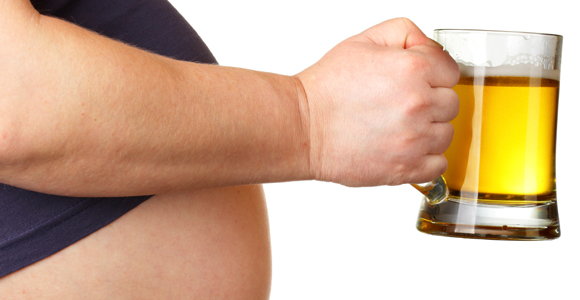You might notice a man struggling to fit his large stomach underneath the bar at a pub and assume he's a regular beer drinker because of his weight--but is that beer really the reason behind that belly? In a word, no--but it's a bit more complicated than that. What really causes the infamous "beer belly"?
It's Not the Alcohol Itself
While drinking beer isn't the direct cause of fat accumulation around the waist, the calories consumed from alcohol can add up very quickly and lead to weight gain. Per gram, alcohol contains the second highest concentration of energy of the macronutrients (protein, carbohydrates and fat) at seven calories--just behind fat (nine calories per gram). Weight gain isn't necessarily due to the alcohol itself, but the high consumption of a high-calorie drink.
A 12-ounce glass or bottle of light beer is generally around 100 calories, and heavier types can range from 150 to 170 calories. This doesn't sound too bad, right? But how many people stop at just one? The recommendations for drinking in moderation are two drinks per day for men and one per day for women, but most people have a few drinks over the course of an evening. Once you start calculating the calories of, for example, four heavy beers (600 to 680 calories total), you realize it is equivalent to the amount found in a full meal.
Why Is a Large Waistline Associated with Beer?
Wine and spirits are often consumed slower than beer due to the higher alcohol content; therefore, a person might drink more beer in one sitting than other types of alcohol. The increase in volume consumed will typically lead to more calories consumed and more weight put on, which is potentially where the "beer belly" idea stems from.
Don't Completely Blame the Beer
Unlike carbohydrates, protein and fat from whole foods, alcohol doesn't provide any feelings of satiety. Therefore, a lot of calories are consumed in liquid form, but you don't register feeling as full as you would by getting those calories from solid food. Adding fuel to the fire, alcohol increases your appetite and impairs your decision making, which leads to eating a few slices of pizza or chicken wings for dinner, instead of your usual roast chicken and vegetables.
You can see now how the calories really add up during a night out. Excess calories, wherever they come from, are stored as fat. Where that fat storage occurs, however, typically depends on genetics, age and hormones. In general, men seem to store extra fat around the belly, while women tend to store fat around the hips and thighs. This probably adds to the "beer belly" stereotype of an older man with a gut.
While a large belly isn't necessarily due to drinking beer, high consumption of alcohol often leads to weight gain and, therefore, the "beer belly" stereotype.
Carolyn McAnlis, RDN, is a Registered Dietitian Nutritionist who has a special interest in preventing chronic disease through nutrition. She graduated from Syracuse University with a Bachelor of Science in Nutrition Science & Dietetics and a minor in Psychology. After completing a full-time dietetic internship at the University of Virginia Health System, she has developed a passion for convincing others that healthy food can be delicious through her blog A Dietitian in the Kitchen.



